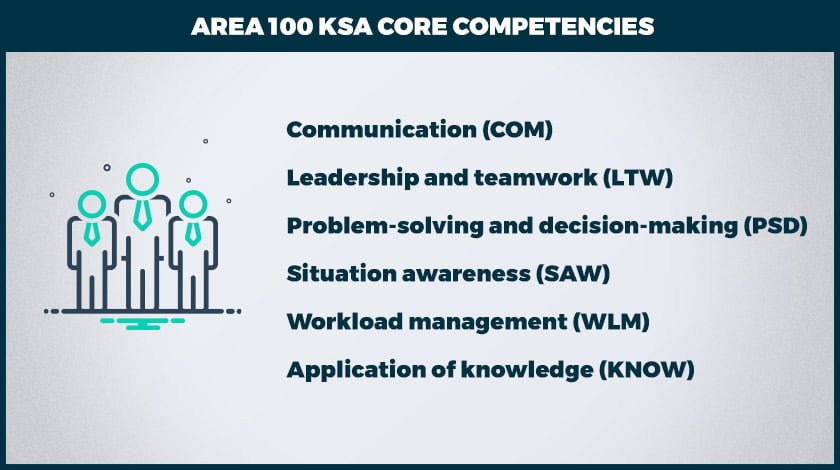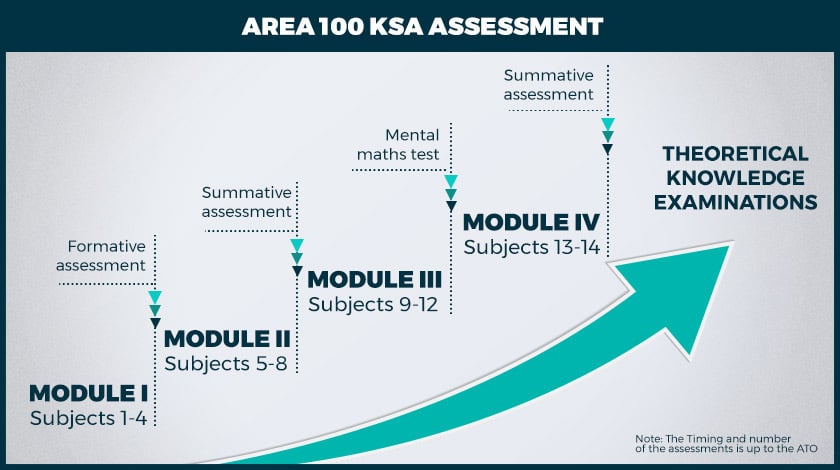Photo: BAA Training
Reading Time: 4 minutesArea 100 KSA is a new philosophy in pilot training that concentrates on moving away from fact-based education towards competency-based training and assessment (CBTA). The new holistic approach to pilot training aims to develop and assess pilots’ Knowledge, Skills, and Attitudes (KSA) from day one at ground school and underlay the whole theoretical knowledge training system. EASA mandates ATOs to embody the concept into their training syllabus no later than 2022 January 31. But how? And most importantly – why? Let’s explore in more detail.
Critical triggers for Area 100 KSA
Although faulty equipment, bad weather conditions, and other aspects can play significant roles in aircraft crashes, many research types show that the human factor is the cause by far more often. In the 1970s, NASA established that flight crew behaviors were a major causal factor in 70% of aviation accidents. In 2003, Boeing attributed 80% of commercial air disasters to human error.
According to EASA Annual Safety Review 2020, approximately a quarter of commercial air transport large airplane accidents reports identify human factors (HF) issues. The peak year by human factor caused accidents was 2016, based on the data below. However, at the time of publishing the report, EASA made a note that the we must view the figure for 2019 as preliminary and likely to increase.

Although pilots might be suitable to perform their duties, they often lack certain competencies, understanding, and soft-skills. A few years ago, Ryanair claimed publicly that more than 50% of pilot candidates were not good enough. Other airlines were later making similar statements. Regulators started questioning what precisely the applicants lacked, and the answer seemed rather self-evident – non-technical skills.
What is Area 100 KSA?
Area 100 KSA is a part of a broader concept – CBTA – developed mutually by the International Civil Aviation Organization (ICAO), the International Air Transport Association (IATA), the International Federation of Air Line Pilots’ Associations (IFALPA), and other industry partners.
CBTA, which stands for competency-based training and assessment, is oriented towards helping student pilots to develop and demonstrate core technical and behavioral competencies to do their job successfully. Among the technical ones, for instance, there are two Aircraft Flight Path Management related competencies – Manual Control and Automation. In contrast, a combination of Knowledge, Skills, and Attitudes (KSA) make up the following behavioral competencies:
- Communication (COM)
- Leadership and teamwork (LTW)
- Problem-solving and decision-making (PSD)
- Situation awareness (SAW)
- Workload management (WLM)
- Application of knowledge (KNO)

“There have been cases in aviation history when it was vital to demonstrate specific competencies, but, unfortunately, they were not there when the flight crews needed them most. Confronted by one aircraft engine’s failure out of the two built-in engines, a flight crew mistakenly deactivated the working engine. This action destroyed any hope to land safely,” explained Arunas Miezanskas, Head of Training at BAA Training, illustrating the importance of pilots nurturing and manifesting particular competencies.
EASA argues that extending the key competencies of pilots will improve their ability to make informed decisions. Therefore, it mandates ATOs to reorganize their pilot training programs to keep them compliant with Area 100 KSA.
ATOs to integrate the new approach
ATOs will have to introduce scenario-based teaching and assessment to Ab Initio programs (ATPL, CPL, MPL) and design exercises that would best train the competencies mentioned above.
EASA emphasizes that flight academies should expose students to real-world situations, encouraging them to develop effective strategies to deal with emergency events, foster resilience, etc. However, ATOs do have flexibility in terms of the range of exercises as long as they meet the KSA approach. “Tell me, and I will forget. Show me, and I will remember. Involve me, and I will understand forever,” – this Chinese philosopher’s Confucius’s phrase unveils the meaning of KSA. In other words, ATOs will have to adequately prepare students not only for the moment of examination but for the entire pilot career.
Assessment framework
When it comes to assessment, training providers have less flexibility and have to follow the framework set by EASA. Students will have to complete one formative assessment, two summative assessments, and one mental math test. Below is one of the examples of how the assessments can be distributed over the learning process. The timing and the number of the assessments (if above the outlined minimum) are up to the ATO.

As students progress with their KSAs, the assessments’ contents will be leveling up as well. The first formative assessment must create room to develop the competencies and ask questions. The following two summative assessments must collectively give the student opportunity to demonstrate the competencies in all KSA learning objectives. The instructors will use ATO’s performance indicators to assess the students’ KSAs and provide feedback. The mental math test should be scenario-based and include estimations and calculations. There will be no multiple-choice questions, and students will not be allowed to use calculators.
The competent authorities will not take the competency-based approach, and the examination system in CAA will remain the same. However, ATOs will be responsible for assessing student pilots’ ability in each of the Area 100 KSA competencies before they take their final theoretical knowledge examination.
Ultimately, ATOs can implement Area 100 KSA in a reasonably pragmatic fashion, utilizing best practices to meet airlines’ needs and develop a “thinking“ pilot mindset. Based on EASA “European Industry Questionnaire,” 97.3% of the respondents answered that “developing the trainee’s understanding and knowledge, skills and attitudes is important and should commence on day one of the GS.“

